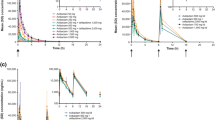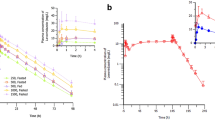Summary
The bioavailability of the recently developed 1 g dispersible tablet form of amoxicillin (B) and the 1 g dispersible tablet in suspension form (C) were compared to that of the 1 g standard reference formulation (A). Twelve healthy volunteers were involved in this single-dose, open, randomized, three-way cross-over study. The mean peak serum levels were 14.1±4.1 μg/ml after A, 15.1 ±3.1 μg/ml after B and 15.1±5.4 μg/ml after C. The area under the drug concentration versus time curves were 47.6±12.0 μg.h/ml after A, 52.8±10.2 μg.h/ml after B and 51.1±13.8 μg.h/ml after C. On the basis of these two pharmacokinetic parameters, the three formulations were found to be bioequivalent. In addition, the predicted serum concentrations during multiple dosing (3 times a day), derived from the corresponding mean concentrations after a single 1 g dose of C showed that 8 hourly administration would yield therapeutic serum concentrations for infections such as uncomplicated community-acquired pneumonia due to susceptible or less susceptible strains in otherwise healthy subjects.
Similar content being viewed by others
References
Macfarlane J.T. (1987): Treatment of lower respiratory infections. Lancet, II, 1446–1449.
Appelbaum P.C. (1992): Antimicrobial resistance inStreptococcus pneumoniae: an overview. Clin. Infect. Dis., 15, 77–83.
Doern G.V. (1994): Emergence of antimicrobial resistance withStreptococcus pneumoniae, Haemophilus influenzae andNeisseria species. 34th Interscience Conference on Antimicrobial Agent and Chemotherapy. Orlando. S91(C), 288.
Klugman K.P. (1994): Management of antibiotic-resistant pneumococcal infections. J. Antimicrob. Chemother., 33, 191–193.
Gibaldi M., Perrier D. (Eds) (1982): Pharmacokinetics. New York: Marcel Dekker, 451–457.
Westlake W.J. (1976): Symmetrical confidence intervals for bioequivalence trials. Biometrics, 32, 741–744.
Schuirmann D.J. (1987): A comparison of the two one-sided tests procedure and the power approach for assessing the equivalence of average bioavailability. J. Pharm. Biopharm., 15, 657–680.
Steinijans V.W., Hauschke D., Jonkman J.H.G. (1992): Controversies in bioequivalence studies. Clin. Pharmacokinet., 22, 247–253.
Spyker D.A., Rugloski R.J., Vann R.L., O’Brien W.M. (1977): Pharmacokinetics of amoxicillin: dose dependence after intravenous, oral, and intramuscular administration. Antimicrob. Agents Chemother., 11, 132–141.
Bodey G.P., Nance J. (1972): Amoxicillin: in vitro and pharmacological studies. Antimicrob. Agents Chemother., 1, 358–362.
Duval J., Soussy C.J. (1973): Activité antibactérienne et pharmacocinétique de l’amoxicilline. Comparaison avec l’ampicilline. Med. Malad. Infect., 12, 525–531.
Croydon E.A.P., Sutherland R. (1970): α-Amino-p-hydroxybenzylpenicillin (BRL 2333), a new semisynthetic penicillin: absorption and excretion in man. Antimicrob. Agents Chemother., 4, 427–430.
Sutherland R., Croydon E.A.P., Rolinson G.N. (1972): Amoxicillin: a new semisynthetic penicillin. BMJ, 3, 13–16.
Hespe W., Verschoor J.S.C., Olthoff M. (1987): Bioavailability of new formulations of amoxicillin in relation to its absorption kinetics. Arzneimittelforschung., 37, 372–375.
Comité de l’antibiogramme de la société française de microbiologie (1994), Path. Biol., 42, 8, I–VIII.
Welling P.B., Huang H., Koch P.A., Craig W.A., Madsen P.O. (1977): Bioavailability of ampicillin and amoxicillin in fasted and non fasted subjects. J. Pharm. Sci., 66, 549–552.
Westphal J.F., Deslandes A., Brogard J.M., Carbon C. (1991): Reappraisal of amoxicillin absorption kinetics. J. Antimicrob. Chemother., 27, 647–654.
Sjövall J. (1979): Dose dependence in human absorption of aminopenicillins. Infection, 7, S458-S462.
Sjövall J., Alvan G., Westerlund D. (1985): Dose-dependant absorption of amoxicillin and bacampicillin. Clin. Pharmacol. Ther., 38, 241–250.
Sjövall J., Alvan G., Akerlund J.E. et al. (1992): Dose-dependant absorption of amoxicillin in patients with an ileostomy. Eur. J. Clin. Pharmacol., 43, 277–281.
Paintaud G., Alvan G., Dahl M.L., Grahnen A., Sjövall J., Svensson J.O. (1992): Nonlinearity of amoxicillin absorption kinetics in human. Eur. J. Clin. Pharmacol., 43, 283–288.
Vogelman B., Craig W.A. (1986): Kinetics of antimicrobial activity. J. Pediatr., 108, 835–840.
Vogelman B., Gudmundsson S., Legett J., Turnidge J., Ebert S., Craig W.A. (1988): Correlation of antimicrobial pharmacokinetic parameters with therapeutic efficacy in an animal model. J. Infect. Dis., 158, 831–847.
Legett J., Fantin B., Ebert S. et al. (1989): Comparative antibiotic dose-effect relations at several dosing intervals in murine pneumonitis and thigh-infection models. J. Infect. Dis., 159, 281–292.
Drusano G.L. (1988): Role of pharmacokinetics in the outcome of infections. Antimicrob. Agents Chemother., 32, 289–297.
Bundtzen R.W., Gerber A.U., Cohn D.L., Craig W.A. (1981): Postantibiotic suppression of bacterial growth. Rev. Infect. Dis., 3, 28–37.
Bennett S., Vogelman B., Craig W.A. (1985): Postantibiotic effects. J. Antimicrob. Chemother., 15, S37-S46.
Vogelman B., Gudmundsson S., Turnidge J., Legett J., Craig W.A. (1988): In vivo postantibiotic effect in a thigh infection in neutropenic mice. J. Infect. Dis., 157, 287–298.
Leng B.M., Lacut J.Y., Aubertin J.M. (1976): Pharmacokinetics of amoxycillin according to administration schedule. J. Int. Med. Res., 4, 449–453.
Neu H.C. (1981): Current practices in antimicrobial dosing. Rev. Infect. Dis., 3, 12–18.
Kunin C.M. (1981): Dosage schedules of antimicrobial agents: a historical review. Rev. Infect. Dis., 3, 4–11.
Bakker-Woundenberg I.A.J.M., Van der Berg J.C., Fontijne P., Michel M.F. (1984): Efficacy of continuous versus intermittent administration of penicillin G inStreptococcus pneumoniae pneumonia in normal and immunodeficient rats. Eur. J. Clin. Microbiol., 3, 131–135.
Norbring F. (1981): Current practice in penicillin dosing. J. Antimicrob. Chemother., 8, S1-S6.
Moreno F., Crisp C., Jorgensen J.H., Patterson J.E. (1994): The clinical and molecular epidemiology of bacteriamia due toStreptococcus pneumoniae isolates not susceptible to penicillin at a University Hospital. 34th Interscience Conference on Antimicrobial Agent and Chemotherapy. Orlando., S41, C10.
Bedos J.P., Vallée E., Moine P., Chastang CI. (1994): A two years’ survey ofStreptococcus pneumoniae (Sp) isolates in Bichat-Claude Bernard Hospital, Paris, France: epidemiology data, risk factors of infection by penicillin nonsensitive strains. 34th Interscience Conference on Antimicrobial Agent and Chemotherapy. Orlando., S41, C12.
Author information
Authors and Affiliations
Rights and permissions
About this article
Cite this article
Prevot, MH., Jehl, F. & Rouveix, B. Pharmacokinetics of a new oral formulation of amoxicillin. European Journal of Drug Metabolism and Pharmacokinetics 22, 47–52 (1997). https://doi.org/10.1007/BF03189784
Received:
Issue Date:
DOI: https://doi.org/10.1007/BF03189784




